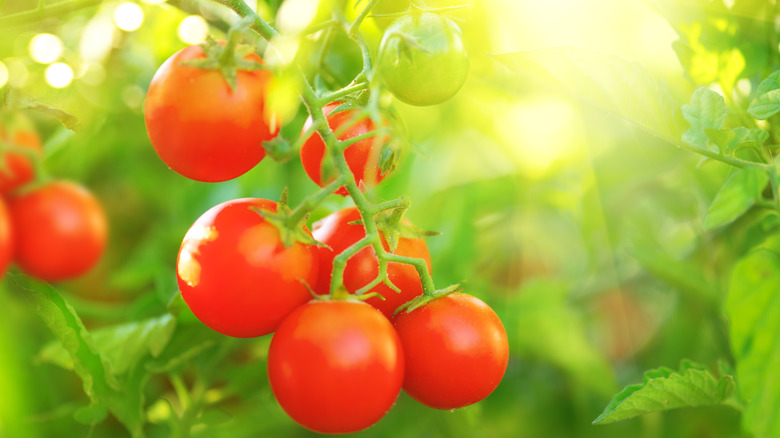Scientists Say This Fruit Could Soon Be A Source Of Vitamin D
No matter how you say it, the tomato is a popular fruit that shows up in some of our favorite foods. It's the main ingredient in many dishes, from Panzanella to pasta sauce, and now the tasty nightshade might be a go-to source of the sunshine vitamin. Nature Plants explains how scientists biofortified tomatoes to increase their vitamin D levels, along with ours.
According to Healthline, getting enough vitamin D is crucial to our health and wellness. An essential element to developing and strengthening our teeth and bones, vitamin D can also increase our immunity to certain diseases and improve our moods. Our bodies can absorb vitamin D from sunlight exposure and absorb it from food sources like dairy, seafood, and meat.
Vitamin D deficiency and insufficiency affect the health and wellness of people all over the world. Getting the recommended amount from sun exposure can be difficult if you live in an area that doesn't get a lot of sunlight or has heavy pollution, you're an avid sunscreen user, or you have darker toned skin. If you follow a plant-based diet, getting the right amount of vitamin D from food sources can be a challenge. By utilizing new gene-editing technology, scientists have discovered a way to substantially increase the amount of vitamin D3 in tomatoes, and it could be a game-changer for the global community.
How scientists are increasing vitamin D in tomatoes
CNN notes that eating foods heavy in vitamin D is likely the most beneficial way to increase your levels. Still, that dietary goal can be out of reach for the 1 billion people struggling with vitamin D deficiency globally. Using the CRISPR-Cas9 gene-editing technology that won developers a Nobel prize in 2020, scientists have figured out how to alter the way tomatoes make vitamin D without changing their flavor.
Provitamin D3 is the compound in our skin that makes vitamin D, and it's also abundant in unripened tomatoes and their leaves. In tomatoes, provitamin D3 is converted into cholesterol that goes on to grow a delicious fruit with low levels of vitamin D. When the gene responsible for the conversion is knocked out with the CRISPR-Cas9 editing tool, the sunshine vitamin is allowed to build up as the tomato ripens under UVB light. The result is a tomato with the same amount of vitamin D found in two eggs or an ounce of tuna.
According to CNN, scientists in the U.K. are currently testing edited tomatoes grown under natural sunlight to see if they produce the same amount of vitamin D as those developed under UVB lights. The results from the crops that will ripen in June might have hugely beneficial implications for people who can't access sources of vitamin D. They might be able to up their levels by a quick trip to the produce department or farmer's market.

